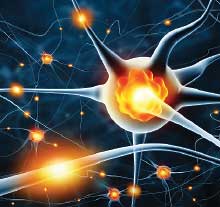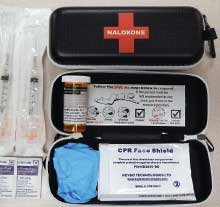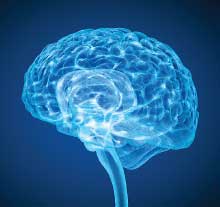Journal Digest
Vasopressin Levels Tied to ASD-Related Social Deficits

Monkeys with low sociability appear to have lower levels of the hormone vasopressin in cerebrospinal fluid (CSF) than those who are more social, according to a study in Science Translational Medicine. The researchers found the same was true when comparing levels of the hormone in a small group of children with autism spectrum disorder (ASD) with those without autism.
The findings suggest vasopressin could be a therapeutic target for improving the social deficits associated with ASD and other psychiatric disorders.
Researchers at the California National Primate Research Center and colleagues studied the behavior of 42 male rhesus monkeys and identified a subgroup of low-social animals that spent less time engaging in grooming and other social activities. The researchers then compared the concentrations of several molecules associated with social behavior in the CSF of low-social and high-social monkeys. They found that vasopressin was notably reduced in low-social monkeys. The levels of oxytocin, another key social hormone, were not associated with sociability.
The researchers confirmed this association between vasopressin and social levels in a second group of monkeys. They subsequently obtained CSF from seven boys with ASD who were undergoing a lumbar puncture for other reasons. The children with ASD had lower levels of vasopressin compared with seven children without autism.
The investigators cautioned that all the children and animals they studied were male, so additional studies in females are needed.
Parker K, Garner J, Oztan O, et al. Arginine Vasopressin in Cerebrospinal Fluid is a Marker of Sociality in Nonhuman Primates. Sci Trans Med. 2018; (10)439: eaam9100.
CBT in Children With Anxiety Not Impacted by ADHD

Comorbid attention-deficit/hyperactivity disorder (ADHD) does not adversely impact the effectiveness of cognitive-behavioral therapy (CBT) for treating children and adolescents with anxiety, reports a study in the Journal of the American Academy of Child & Adolescent Psychiatry.
These findings come from an analysis of 842 youth (aged 6 to 18) and their parents who participated in a group-based, family CBT treatment program known as “Cool Kids” at Macquarie University in Sydney, Australia, between 2000 and 2011. Of the 842 youth included in the trial, 94 had comorbid ADHD.
The researchers found that ADHD comorbidity did not predict any worse response or remission of anxiety after CBT. This lack of association held true when looking at specific ADHD subtypes (predominantly inattentive, predominantly hyperactive, or combined).
The CBT even improved ADHD symptoms in the children by an average of 1 to 1.5 points on the Anxiety Disorders Interview Schedule for DSM-IV (which includes a module for ADHD). This improvement was sufficient for about a third of the children to drop below the cut-off for ADHD, the authors wrote.
The authors noted that the participants in this analysis were children with primary anxiety presenting to an anxiety clinic with mild to moderate ADHD, and the outcomes may not apply to all youth with comorbid anxiety and ADHD.
Gould K, Porter M, Lyneham H, Hudson J. Cognitive Behavioral Therapy for Children With Anxiety and Comorbid Attention-Deficit/Hyperactivity Disorder. J Am Acad Child Adolesc Psychiatry. May 15, 2018. [Epub ahead of print]
Dopamine Linked With Avoidance Behaviors

Researchers at the University of Maryland School of Medicine have found a direct link between dopamine and avoidance behaviors. The association of dopamine with positive reinforcement has been known for some time, but this study, published in Current Biology, is the first to identify a role for dopamine in avoiding negative events.
The researchers exposed rats to a tone followed by an electric shock to the foot. The shock came a few seconds after the tone and could be avoided by quickly pressing a small lever after hearing the sound. Using a technique known as optogenetics, the researchers could adjust the activity of dopamine neurons in the brains of the animals. The animals that released high levels of dopamine in the nucleus accumbens (a key part of the brain’s reward system) learned to avoid a shock more quickly and more often than those with low dopamine activity.
Interestingly, once the rats learned the lever trick, adjusting dopamine release no longer had any effect on their ability to press the lever when needed. This suggests that dopamine is involved in acquiring an avoidance memory, but not in its maintenance.
Wenzel J, Oleson E, Gove W et al. Phasic Dopamine Signals in the Nucleus Accumbens That Cause Active Avoidance Require Endocannabinoid Mobilization in the Midbrain. Curr Biology. 2018; 28(9): 1392-1404.e5
Take-Home Naloxone Reduces Overdose Deaths By a Quarter

After a take-home naloxone program in British Columbia was expanded in 2016, the province saw a 26 percent drop in the number of people who died by overdose, according to a study in Lancet Public Health.
The investigators compiled data from coroners reports between January 2012 and October 2016 and identified 2,121 illicit drug-related deaths during this period, including 677 deaths related to fentanyl. During this same period, 19,074 take-home naloxone kits were distributed in the province.
The investigators calculated that 298 total overdose deaths (including 155 fentanyl deaths) were averted by the take-home naloxone program; 226 of these deaths were averted in 2016 alone, following a sixfold expansion in kit distribution. This translated to one death averted for every 85 take-home naloxone kits distributed, and one death averted for every 10 kits used.
Combining “THN [take-home naloxone kits] with treatment and other harm-reduction strategies could have an additive impact on the number of deaths averted and might further reduce the number of overdoses and associated demands on the health care system,” the authors concluded.
Irvine M, Buxton J, Otterstatter M, et al. Distribution of Take-Home Opioid Antagonist Kits During a Synthetic Opioid Epidemic in British Columbia, Canada: A Modelling Study. Lancet Public Health. 2018; 3(5): e218-e225.
Higher IQ May Mean Fewer Dendrites in Cortex

Studies show that people with high intelligence are more likely to have larger brains, leading some to assume they must also have more neurons. A study published in Nature Communications found that higher intelligence is associated with a lower density of dendrites (the spiny extensions of neurons through which signals from other neurons are received) in the cortex.
A team of researchers led by investigators at Ruhr-Universität Bochum in Germany used neuroimaging to measure the density of dendrites in 259 adults. All the participants completed IQ tests to assess intelligence.
When comparing the two sets of data, the researchers found that higher IQ scores were associated with lower dendrite density in the cerebral cortex. A neuroimaging analysis on a second cohort of 498 participants found a similar association between dendrites and IQ.
This association goes counter to the idea that more is better, but the researchers noted that brain maturation involves not only neuronal proliferation, but also the pruning of neuron connections to make the brain more efficient.
“These results suggest that the neuronal circuitry associated with higher intelligence is organized in a sparse and efficient manner, fostering more directed information processing and less cortical activity during reasoning,” they wrote.
Genç E, Fraenz C, Schlüter C, et al. Diffusion Markers of Dendritic Density and Arborization in Gray Matter Predict Differences in Intelligence. Nat Commun. 2018. 15;9(1): 1905.
Child Suicide Rates Reported by Race

The suicide rate in black children aged 5 to 12 is nearly twice that of white children of the same age, according to a study in JAMA Pediatrics.
Using data from the Centers for Disease Control and Prevention collected between 2001 and 2015, researchers from Ohio State University and colleagues identified 1,661 suicide deaths among black youth aged 5 to 17 and 13,341 suicide deaths among white youth in the same age range. In both groups, about 74 percent of the decedents were boys and 26 percent were girls.
The researchers found, however, that the racial difference was moderated by age. Among children aged 13 to 17, the suicide rate was approximately 42 percent lower among black youth (1.26 per 100,000) than white youth (2.16 per 100,000), but in children aged 5 to 12, the black youth had 1.82 times the rate of suicide. This pattern was true for both boys and girls.
“Our findings underscore the need to explore potential race-related differences in mechanisms of suicide and to develop more effective suicide detection and prevention efforts for black children,” the authors wrote. “Ongoing surveillance efforts must reflect the dynamic association between race and age-related risk for youth suicide.” ■
Bridge JA, Horowitz L, Fontanella C, et al. Age-Related Racial Disparity in Suicide Rates Among US Youths from 2001 to 2015. JAMA Pediatrics. May 21, 2018. [Epub ahead of print]



